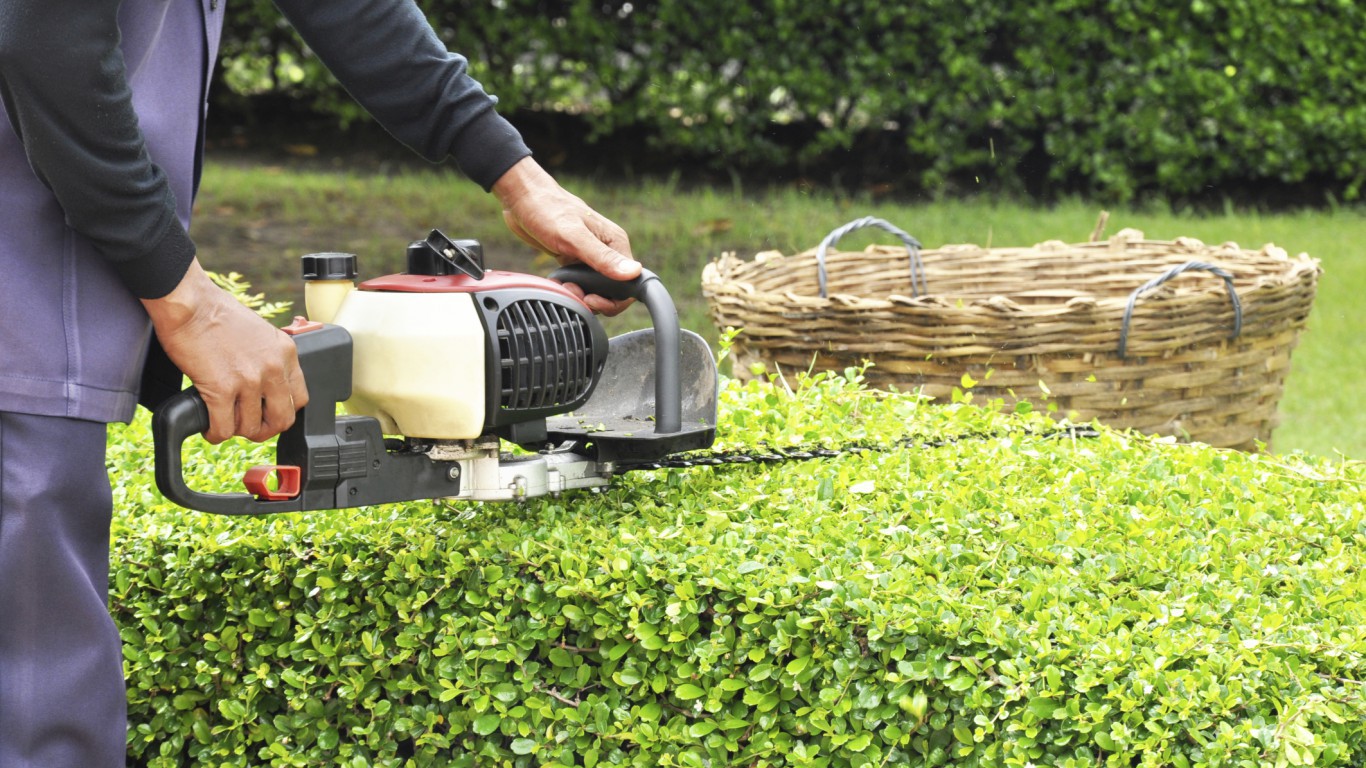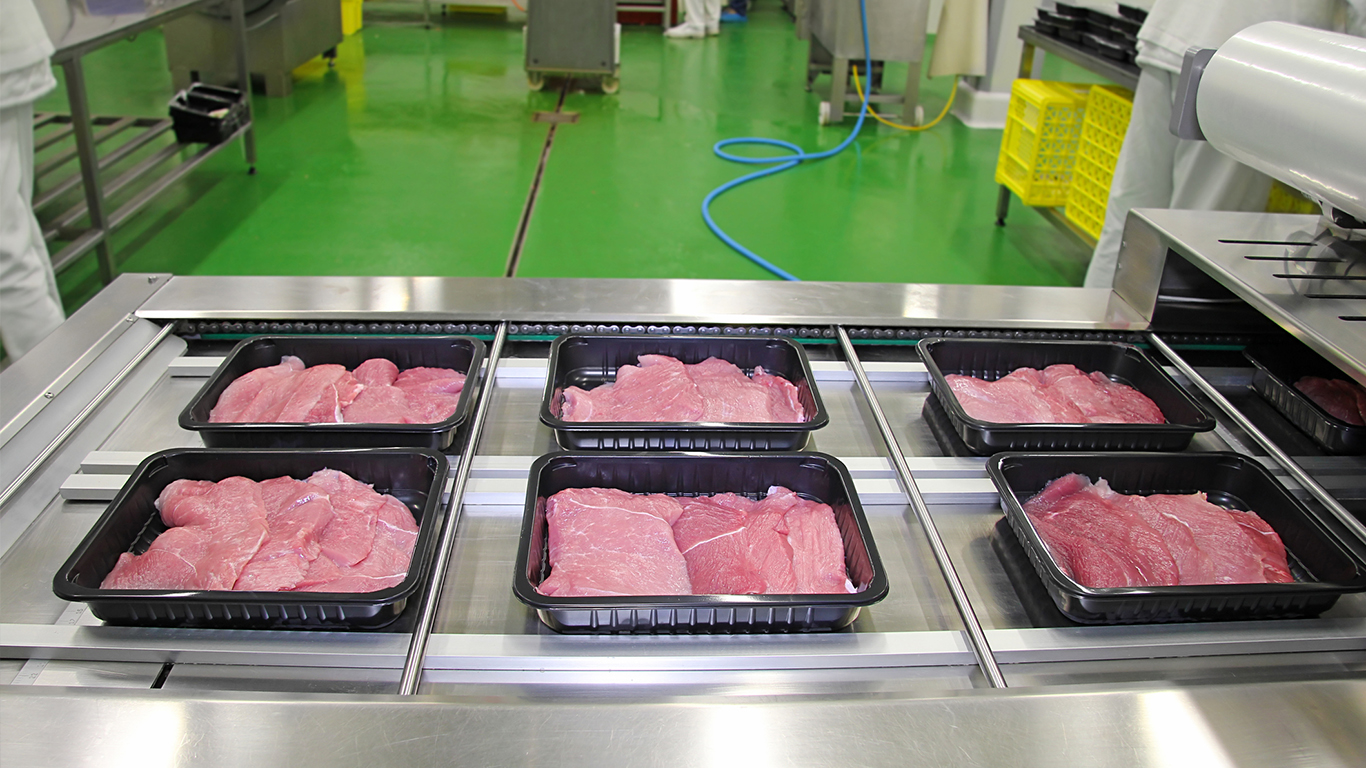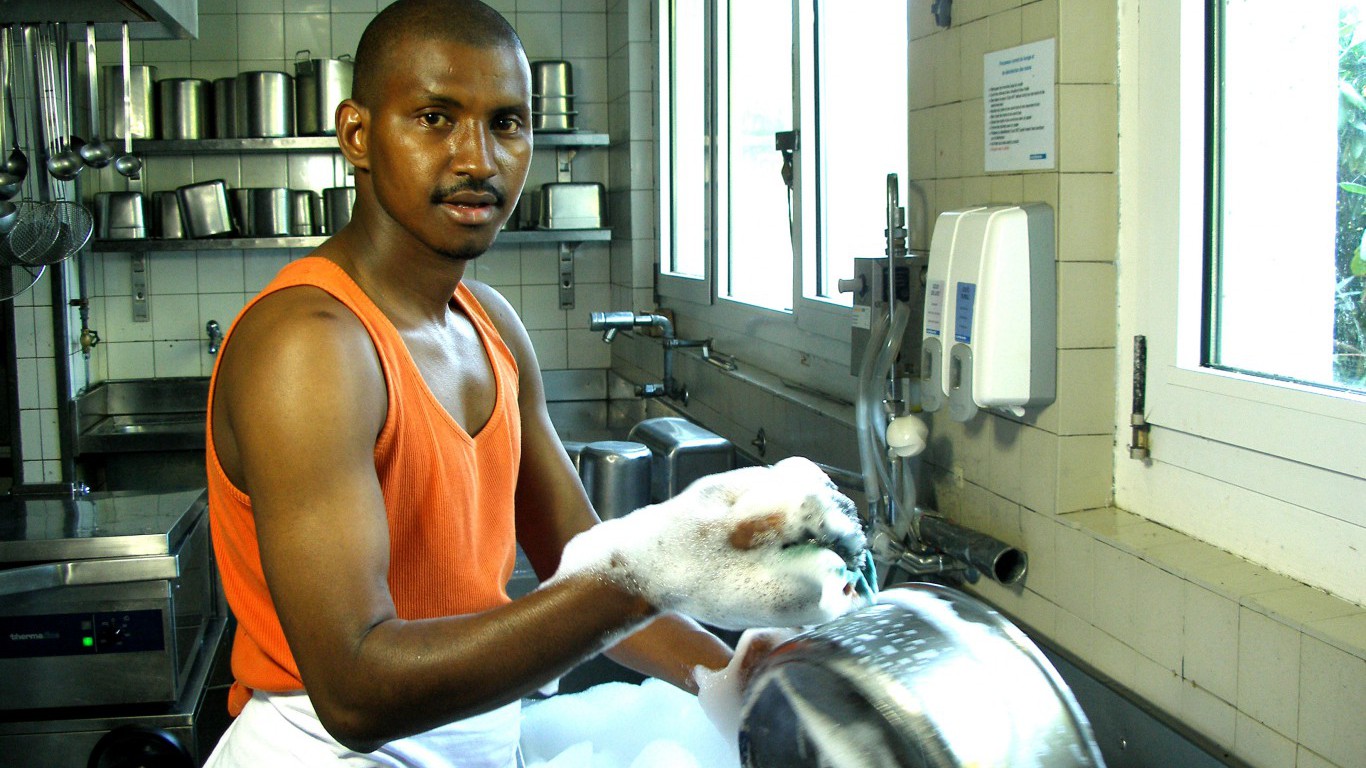Special Report
25 Lowest Paying Jobs in America

Published:
Last Updated:

The U.S. economy has recovered considerably since the financial crisis of 2008-2009, with unemployment down substantially from its recession peak of nearly 10%. New minimum wage laws in some U.S. states, as well as wage hikes in retail and food services companies in recent years, have also helped raise earnings among American workers.
The share of hourly-paid workers with earnings at or less than the federal minimum wage fell from 3.9% in 2014 to 3.3% in 2015, and again to 2.7% last year. Despite the recovery and the occasional worker-friendly company announcements, the U.S. economy is full of exceptionally low-paying jobs.
[in-text-ad]
24/7 Wall St. reviewed the latest job market data from the U.S. Labor Department to determine America’s 25 lowest paying jobs. To ensure low wages for a particular occupation could not be entirely attributed to part-time employment, we only considered full-time, salaried positions.
Click here to see the lowest paying jobs in the country.
In an email exchange with 24/7 Wall St., chief regional economist Martin Kohli highlighted several notable characteristics common across these low-wage jobs. “The most noticeable characteristic of many of the lowest-paid occupations is that they typically don’t require educational attainment beyond high school.”
In addition to fewer years of training required, these occupations often involve manual labor. While jobs requiring manual labor have been vulnerable to automation and outsourcing, employment growth in many of the jobs listed here is expected to keep pace with the overall job growth rate nationwide.
A number of the nation’s lowest paying jobs are quite common. The number of people working as cashiers is well over 1 million, as is the number of people working as cooks. In fact, all but five of the 25 lowest paying full-time occupations employ more than 100,000 people nationwide.
Minimum wage laws have a major impact on low-wage workers, especially in states with relatively high concentrations of low-wage occupations. Most of the highest paying states for these jobs are states with the highest minimum wages.
Kohli observed that in some of these jobs, women make up an outsized share of employment. In 18 of the 25 lowest paying jobs, the share of employees who are women exceeds the national average percentage of 44.3%.
To identify the lowest paying jobs in America, 24/7 Wall St. reviewed 2016 annual average median weekly earnings for full-time wage and salary workers by detailed occupation from the Bureau of Labor Statistics. The number of workers employed in each occupation was also obtained from the BLS. The estimated yearly earnings for each occupation was calculated from the median weekly earnings figures.
These are the lowest paying jobs in America.

25. Nursing, psychiatric, and home health aides
> No. of workers: 1,386,000
> Median weekly earnings: $503
> Est. yearly earnings: $26,156
Nursing, psychiatric, and home health aides assist patients with disabilities, chronic illness, or cognitive impairment with everyday tasks. The typical health aide earns $503 a week, well below the $832 median weekly earnings across all U.S. occupations. While the job’s pay is relatively low, the employment outlook is good. As the U.S. elderly population continues to grow, the BLS projects very strong demand for such workers.
[in-text-ad]

Like many of the nation’s lowest-paid occupations, grounds maintenance workers are usually paid hourly. The typical median weekly wage of workers in these often seasonal jobs is approximately $500. According to the Labor Department, the growth of ground maintenance workers will keep pace with the nation’s labor force growth rate as more workers will be needed for landscaping services, particularly at large universities, corporate campuses, and other large institutions.

Breads, pastries, pies, and other baked goods are widely loved consumer goods. The bakers who make these specialty items often must possess basic math skills to adjust and carry out recipes. Bakers also require physical strength and stamina to lift heavy food items and stand for extended periods. Like many food industry workers, bakers are paid some of the lowest wages in the nation.

The typical full-time car wash employee makes just $491 a week, roughly $350 less than the median weekly earnings for all full-time workers nationwide. Automobile and equipment cleaning is a relatively low-skilled position, and many car wash employees likely earn minimum wage. The highest-paid vehicle cleaners are in Washington D.C. , where the minimum wage of $11.50 per hour is the highest of any state.
[in-text-ad-2]

Miscellaneous personal appearance occupations include such workers as makeup artists, manicurists and pedicurists, shampooers, and skincare specialists. As is generally the case for occupations with the lowest wages, personal appearance jobs generally require fewer years of formal education compared to higher paying jobs.

Nearly every product sold in the United States is sold in its own packaging. Packaging and filling machines are used across a wide array of industries, with the highest concentration of operators working in the fruit and vegetable preservation and specialty manufacturing industry. Operating packing machines requires little formal education, and partially as a result the occupation pays relatively low wages. The typical full-time packaging and filling machine operator earns just $488 a week, far less than $832 median weekly earnings of all full-time workers nationwide.
[in-text-ad]

Not to be confused with agricultural workers, animal caretakers work in a variety of settings, including kennels, zoos, stables, animal shelters, veterinary clinics, and aquariums. According to the Labor Department, there is a growing demand for animal care, particularly for household pets. Job tasks across these occupations vary considerably, and generally these workers are paid very little. Typically, such workers earn less than $500 a week.

Miscellaneous entertainment attendants work in a variety of settings, including amusement parks, locker rooms, and theater dressing rooms. One of the highest concentrations of entertainment attendants is in Polk County, Florida, home to the Legoland theme park. Another is the International Drive region in Orlando, Florida, where Disney World is located. The typical entertainment attendant earns $481 a week, far less than the $832 national median.

Food servers who are not employed by restaurants work in businesses such as hotels, hospitals, and residential care facilities. Employment in the occupation is projected to grow more than twice as fast as the average U.S. job over the next decade. Like other health-related jobs, the growth is largely due to the continued growth of the U.S. elderly population.
[in-text-ad-2]

According to Kohli, many employees in low paying occupations are women. Approximately 84% of personal care aides are women, one of the highest concentrations of any occupation. Also, like many other low paying jobs, the typical full-time personal care aide position requires mostly on-the-job training. The typical personal care aid is paid $477 a week — far less than the $832 national figure.

Including tips and overtime pay, the typical full-time waiter or waitress earns just $470 a week. Roughly half of all waiters and waitresses work part-time and likely earn far less. More and more restaurants are using technology-driven ordering and payment systems, eliminating the need for food service workers. Partially as a result, the number of waiters and waitresses is projected to grow just 3% between 2014 and 2024, slower than the 7% average growth rate for all occupations.
[in-text-ad]

Roughly 73,000 Americans work full-time as automotive and watercraft service attendants. One common automotive attendant service occupation is a gas pumper. The two states with the highest concentration of automotive and watercraft service attendants are Oregon and New Jersey, the only U.S. states where self-service gas stations are prohibited and an attendant is required to pump gasoline for customers.

Like most of the nation’s lowest paid jobs, packers and packagers perform primarily manual labor and do not typically need formal educational credentials. While the manual aspect of the job means these occupations are vulnerable to automation, packing and packaging job growth is expected to at least match the average pace of job growth nationwide.

Laundry services flourish in areas where residents are unlikely to have their own washing and drying machines — densely populated areas with high shares of renters. Renters are the primary customers of laundry services, and the number of renter-occupied households in the United States has increased from 39.7 million in 2010 to 43.7 million in 2015. While the number of laundry and dry-cleaning workers will likely grow, wages will likely remain low. The typical full-time laundry worker earns just $454 a week, far less than the $832 national median.
[in-text-ad-2]

Since the 1960s, demand for childcare workers increased as the share of stay-at-home mothers decreased. More recently, the trend has reversed. According to a recent Pew study, the share of mothers who do not work outside the home was on the rise as recently as 2012. As the number of stay-at-home parents continues to rise, the BLS projects the profession will grow at a slower pace.

Wages of food service workers vary widely across industries and restaurants. The highest paying cook positions are often in fine dining restaurants or luxury hotels, while the lowest paying positions are often at fast food or short order establishments. The typical full-time cook earns just $444 a week, far less than the $832 national median for all U.S. occupations.
[in-text-ad]

Like most food service positions, pay for hosts and hostesses varies widely across industry and geographic region. The highest paid hosts and hostesses tend to be in metropolitan areas with luxury restaurants and hotels such as Atlantic City, New Jersey; Kahului, Hawaii; and Las Vegas, Nevada. Still, the median weekly earnings of hosts and hostesses is just $442, far less than the $832 national figure.

BLS economist Martin Kohli noted that the nation’s lowest paid jobs frequently employ large shares of women, and often include part-time jobs. Close to 85% of maids and housekeeping cleaners are women. Only full-time, salaried maids were considered for this list, and for them the median weekly wage is just $441, among the lowest paid occupations in the country. For the many part-time maids, the weekly wage is likely much lower.

Operating a sewing machine professionally rarely requires a college degree, and it involves manual labor, paid hourly — characteristics common among the nation’s lowest paying jobs. While employment is actually projected to grow for many low paying jobs, sewing machine operator employment will likely shrink in coming years. Not only is the job vulnerable to automation, but garment manufacturing companies are known for outsourcing such jobs.
[in-text-ad-2]


Food preparation workers wash and cut ingredients and are typically employed at restaurants and grocery stores as well as nursing homes and residential care facilities. According to the BLS, demand for such workers will continue to be driven by consumer preference for fresh meals made from scratch, which tends to be more labor intensive. Like other occupations on this list, food preparation workers are quite numerous — there are approximately 477,000 such workers employed full-time across the nation.
[in-text-ad]

The highest paying cashier jobs are often in grocery stores and other general merchandise stores, while the lowest paid cashiers often work in gasoline stations, restaurants, and other eating places. The typical full-time cashier earns just $414 a week, far less than the $832 national figure. Advances in technology may also limit employment growth of cashiers in coming years. As automated payment systems grow in popularity among retailers and food establishments, the number of cashiers will likely increase at a slower pace than most occupations.

Combined food preparation and serving workers have to both prepare and serve the food. While the profession has nearly the lowest salary of any occupation, the number of combined food preparation and serving workers will likely increase rapidly in the near future as fast casual restaurants grow in popularity. Fast casual restaurants — such as Chipotle, Five Guys, and Panera Bread, which offer food without full table service — often have business models that require employees to both prepare and serve food.

The lowest paying occupations tend to require little to no formal education. The typical dishwashing job does not require a high school diploma and pays just $389 a week — less than half the $832 median across all occupations nationwide. Additionally, the number of dishwashers is projected to decline over the next decade. One reason for the projected decline may be the rising popularity among food retailers of industrial dishwashing machines, which are improving in both efficiency and affordability.
[in-text-ad-2]

According to Kohli, many of the lowest paid employees in the United States are women working part-time in the foodservice industry. Roughly 72% of counter attendants are women, one of the highest concentrations of any occupation in one sex. Kohli also noted low paying occupations frequently require little formal education. Most counter serving jobs do not require a high school education and pay the least of any job in the country. Including tips and overtime, the typical full-time counter attendant earns just $374 a week — less than half the $832 weekly median earnings across all occupations.
After two decades of reviewing financial products I haven’t seen anything like this. Credit card companies are at war, handing out free rewards and benefits to win the best customers.
A good cash back card can be worth thousands of dollars a year in free money, not to mention other perks like travel, insurance, and access to fancy lounges.
Our top pick today pays up to 5% cash back, a $200 bonus on top, and $0 annual fee. Click here to apply before they stop offering rewards this generous.
Flywheel Publishing has partnered with CardRatings for our coverage of credit card products. Flywheel Publishing and CardRatings may receive a commission from card issuers.
Thank you for reading! Have some feedback for us?
Contact the 24/7 Wall St. editorial team.